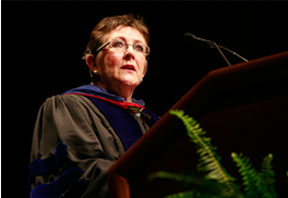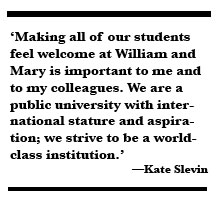Slevin: Naming diversity
 The following statement was made by Kate Slevin, Chancellor Professor
of Sociology, upon receiving the Thomas Jefferson Award during Charter
Day ceremonies. —Ed.
The following statement was made by Kate Slevin, Chancellor Professor
of Sociology, upon receiving the Thomas Jefferson Award during Charter
Day ceremonies. —Ed.
… I want to briefly and candidly share one of the challenges I have
struggled with in recent years as William and Mary students have become
more diverse. I think [that] by sharing this story, those who haven’t
spent day-in and day-out time on campus in recent years will get a
better sense of the innovations that are required as the campus adapts
to new and exciting global realities.
Born and reared in Ireland, I grew up in an extremely homogeneous
society with people who looked and sounded alike. As well, all had
first and last names that were very familiar to me. Even if I strayed
to Great Britain, which I did frequently, I had no problem with typical
British first or last names. Names, I should say, are very important in
my culture of origin. In Ireland, the habit of calling someone
accurately by name—not once but frequently throughout a conversation—is
learned early and often.
In my first decade or so at William and Mary, calling the class roll
presented me with minimal challenge—the Johns and Sarahs, the Caitlins
and Marks were easily pronounced as their last names were familiar. My
style of teaching is very interactive, and I had little problem
recalling or using student names that were, to me, straightforward and
recognizable. My ability to call on students by name was certainly one
factor that encouraged student participation. My cultural training of
not only identifying people by name but of using their names throughout
a discussion served me very well, but it also served student learning
very well because students felt that they were personally recognized
and, as a result, they felt that they had a stake in contributing to
classroom discussion.
 However, as William and Mary became more ethnically and racially
diverse in this past decade, my challenge was to continue to create a
positive classroom climate in the face of my inability to easily
pronounce the names of an increasing number of my students. To be
absolutely frank, calling roll eventually became a nightmare for
me—even when I practiced in advance, which I did, often with the help
of similarly challenged colleagues. I fumbled and stumbled with names
that were unfamiliar to me. I then noticed that my own ignorance began
to change the learning environment of my classes. Determined not to
make an idiot of myself or to embarrass my students, I avoided saying
names that were unfamiliar to me. Students, many born in Virginia but
with family ties to Cambodia, Senegal, Vietnam, Ghana, India, China,
Poland, Japan, Pakistan, Iran, Israel, The Philippines, Korea—and I
could go on—all have names that presented me with what often seemed
like an insurmountable challenge. By naming some students and avoiding
naming others, I created, however unintentionally, a classroom climate
that was less than desirable.
However, as William and Mary became more ethnically and racially
diverse in this past decade, my challenge was to continue to create a
positive classroom climate in the face of my inability to easily
pronounce the names of an increasing number of my students. To be
absolutely frank, calling roll eventually became a nightmare for
me—even when I practiced in advance, which I did, often with the help
of similarly challenged colleagues. I fumbled and stumbled with names
that were unfamiliar to me. I then noticed that my own ignorance began
to change the learning environment of my classes. Determined not to
make an idiot of myself or to embarrass my students, I avoided saying
names that were unfamiliar to me. Students, many born in Virginia but
with family ties to Cambodia, Senegal, Vietnam, Ghana, India, China,
Poland, Japan, Pakistan, Iran, Israel, The Philippines, Korea—and I
could go on—all have names that presented me with what often seemed
like an insurmountable challenge. By naming some students and avoiding
naming others, I created, however unintentionally, a classroom climate
that was less than desirable.
The situation, I am happy to say, did not last long. Once I realized
what was happening, I had a very frank conversation with myself and
came up with a plan to counteract my ignorance and to model for my
students my own willingness to be a lifelong learner, to be a citizen
of the world. Here is what I did and continue to do. On the first day
of class I begin by telling the students about the limits of my own
background and about how challenged I am by names not familiar to me. I
instruct them that throughout the semester they must give me their
first names each time they speak. I tell them that, in a number of
cases, they will become the teacher and I will become the student and
that they have to hang in there with me as I learn to pronounce their
names.
It is not a perfect system (indeed, to be truthful, I have my moments
when I fantasize about invoking current student naming convention by
calling every last student “Dude”! But, overall, my system of learning
names works well because repetition of unfamiliar names helps me grasp
their pronunciation. By semester’s end I can more accurately pronounce
names like Thao, Nihan, Iyabo, Jaja, Takanori, Akshay, Arya and Je
Jung. Just as importantly, I again have a classroom learning climate
that is welcoming to all my students. Indeed, there is no doubt that
the greater diversity of my students is a huge plus in that it brings
to the classroom a rich variety of perspectives from around the world,
perspectives that enrich the educational experience immeasurably.
Making all of our students feel welcome at William and Mary is
important to me and to my colleagues. We are a public university with
international stature and aspiration; we strive to be a world-class
institution. As educators and world citizens, we inevitably face social
change, and we have a choice regarding whether to adapt to that change
in a positive or a negative manner. A positive choice often requires
more work from us and, at times, even a reorientation on our parts. I
trust that I leave you with one small example of how everyone wins when
we accept change in a positive way.
 Skip to main content
Skip to main content
